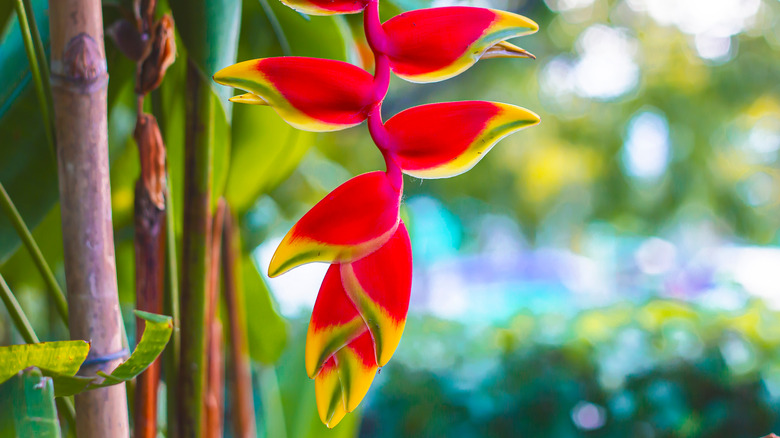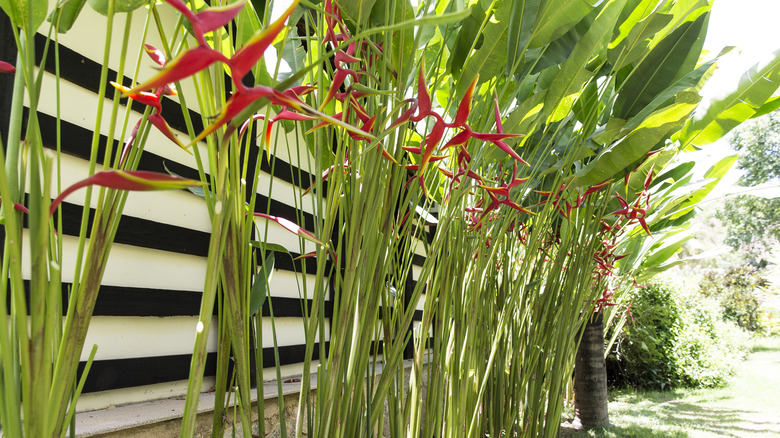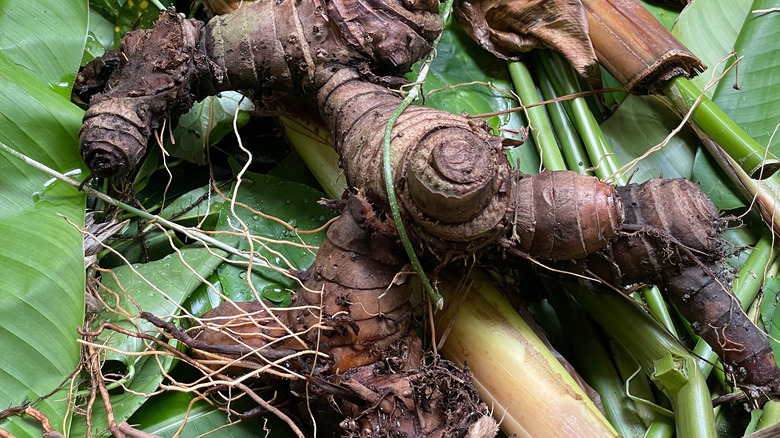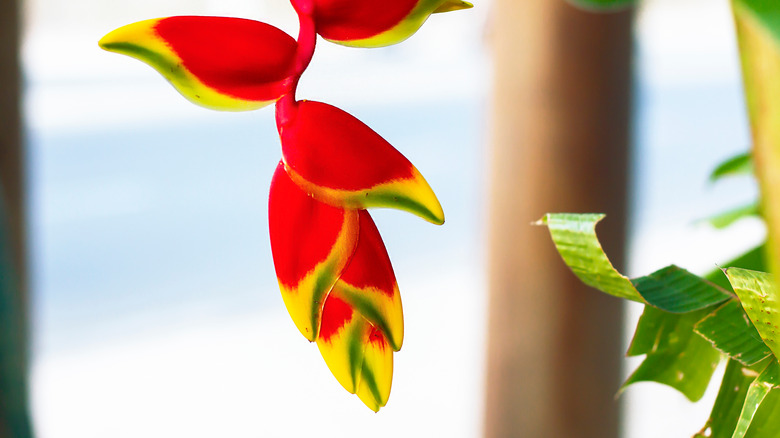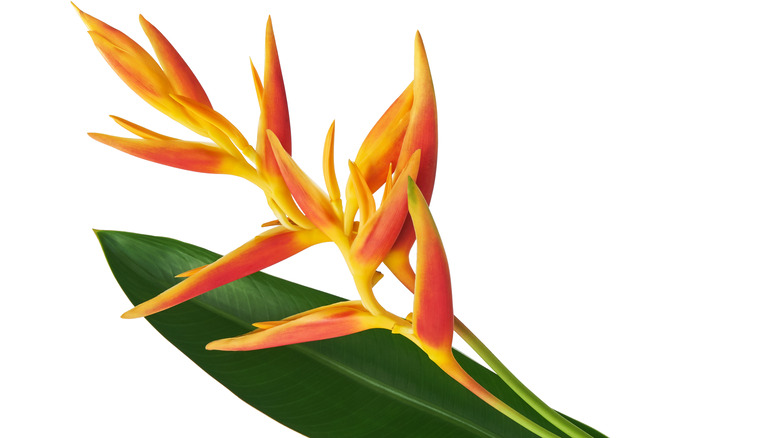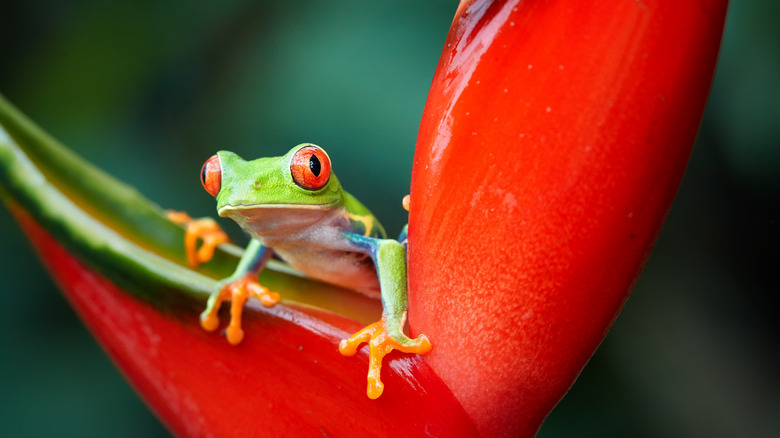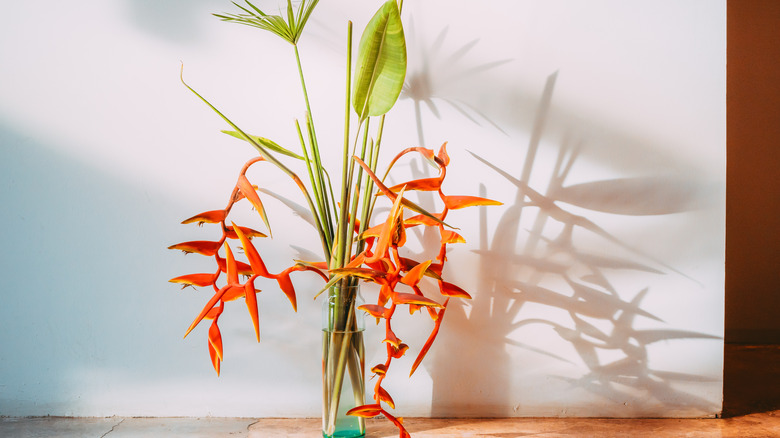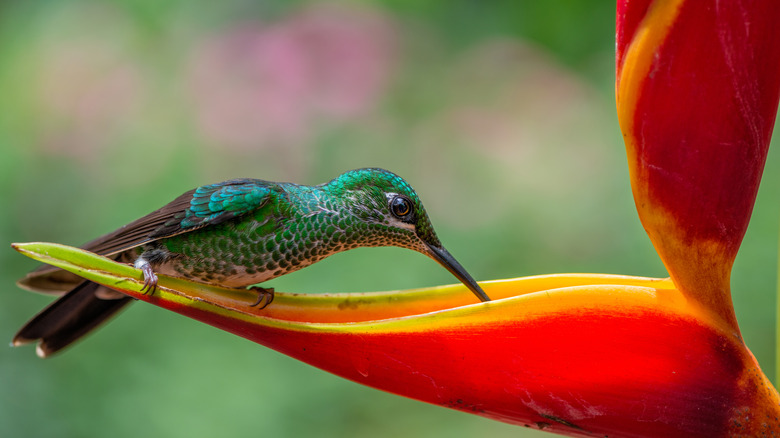Heliconia Lobster Claw Flower: Everything You Need To Know Before Planting
Heliconia rostrata is a large flowering tropical plant with an unusual structure. The root system of the plant is called a rhizome (think of an iris or the ginger root you can find in a supermarket produce aisle). Both leaves and racemes shoot up from the rhizome. Heliconia leaves are similar in size and shape to those of a banana tree, while racemes are stalk-like stems that end with long hanging inflorescences. Once the plant matures, what appear to be very bright red and yellow flowers grow and hang down from the ends of each raceme. In truth, according to University of Florida's IFAS Extension, these are 6 to 8 inch long bracts. Bracts can be easily mistaken for flower petals, but are actually leaf-like clumps that aid in attracting pollinators. Hidden inside each stunning bract are the tiny, and rather insignificant, flowers.
Heliconia rostrata bracts are pendulous, meaning they dangle in a chain-like fashion as they grow downwards, and they are what give this exceptional tropical beauty the apropos nickname of hanging lobster claw. The Heliconia genus is monotypic, therefore it is the only one in the Heliconiaceae family. Within the heliconia genus, however, there are hundreds of species and hybrids.
How to use heliconia lobster claw in a garden
Your outdoor environmental conditions will need to meet some very specific criteria if you're looking to add hanging lobster claws to your landscape or garden. Because all members of the Heliconiaceae family are tropical, they're only hardy in USDA temperature zones 10 and higher (via Gardening Know How).
Consider yourself lucky if you live somewhere warm and humid enough to sustain these uniquely stunning plants. It won't be hard to figure out where to plant them. In a front yard they'll stand on their own to offer a bold greeting to visitors and passersby. You can also use them to paint quite a splash of eye-catching color against a background of lush greens in a garden layout. Pick an area that receives full to partial sun and cover your soil with mulch to help keep the top layer moist.
Most of us who live in mild-to-cold climates will have to settle for importing heliconia through local flower shops and enjoying them as part of a cut floral arrangement. The good news here is the lobster claw bracts of the Heliconia rostrata tend to stand up well to a little travel and stay fresh looking for up to two weeks. Kay's Flower School recommends misting your arrangement daily, as well as cutting an inch from the bottom of the stems every few days. Both of these tips can help keep the cut stalks hydrated and healthy even longer.
How to grow heliconia lobster claw
Heliconia lobster claw can be easily propagated by rhizome division, the process of cutting off sections of its underground root system. A good time to do this is when you are already disturbing the plant in order to repot it. Once the rhizome is free from the pot, brush off excess soil and find a place where you can make a cut that will allow the new piece to have a bud at the node, where new roots will grow. Per the horticultural division at the Te Kura School of New Zealand, a clean cut is important to lower the chances of spreading disease or damaging the plant. It's fine to break off more than one piece, but each one should be planted separately to create its own baby plant.
A second, though more time-consuming, option for growing heliconia, is to pick the fruit after it has ripened and remove the seeds. Wash them well and plant them in seed trays like you would any other garden seed. Water well and leave them in a sunny spot to root and sprout. With a little luck, you should start to see seedlings popping up through the soil within a few weeks.
How to care for heliconia lobster claw
Logee's Greenhouse has specialized in growing and selling potted tropical plants since 1892. Their YouTube channel offers a tutorial regarding the care of hanging lobster claw plants kept indoors where temperatures can be kept above 60 degrees Fahrenheit at all times. Similar to orchids, container planted flowers (or bracts) can stay beautiful for months. High heat and moisture must be maintained at all times. Heliconias simply cannot survive in the cool greenhouses or conservatories of northern climates. Even a cold snap in a southern climate will damage a plant, however it's usually quick and manageable, leaving the plant with enough strength to bounce back.
Leaf damage is a common occurrence from over-fertilization. If you tend towards liquid fertilizer, Logee's recommends occasionally flushing the plants with plain water. When using slow-release granular pellets, apply a lower dose than is typical for flowering plants. Aside from occasional issues with slugs, these plants really don't have much trouble with insects or other pests. Keep an eye out for proper drainage to stay on top of any possibility of root rot, which may happen when plants get cold or stay too wet.
Heliconia varieties
With hundreds of Heliconia species to choose from, there are many fun bract shapes and bright colors to explore. Some hang down like the lobster claw, while others grow upright and erect like the golden torch variety shown above. In their guide to tropical flora, Wildlife of Hawaii lays out a few examples of those most commonly seen on the islands.
- Heliconia bihai, or Macaw flower, is another upright example with deep crimson red floral bracts.
- Heliconia latispatha is known as expanded lobster claw, even though it grows upwards instead of down.
- Heliconia psittacorum has many nicknames involving parrots and parakeets. A much more delicate option than the lobster claw, it is one of the most cultivated varieties. Red parakeet heliconia has also been seen lining roadsides, which means it's becoming naturalized (able to grow on its own in the wild) throughout Hawaii.
- Heliconia psittacorum x spathocircinata is the bright yellow variety called golden torch.
From here you can find many hybrids developed by garden centers. Floral bracts can be found in vivid solid colors, paler shades of yellow, and dramatic two-tones of red and orange.
Is heliconia lobster claw toxic?
Is that red-eyed tree frog smiling? It's safe to say the tropical amphibians love to perch themselves atop the claws of a good heliconia bract, and gosh, they look cute doing it. Tree frogs sometimes even make a home out of the tiny pools of water that collect there, along with other aquatic microorganisms. In fact, according to the University of Wisconsin-Madison's Horticulture Extension, there are many species of wildlife that rely on heliconias for food and hiding spots, like spiders and Honduran white bats. And then there's the owl butterfly (Caligo oileus) and the heliconia bug (Leptoscelius tricolor Westwood), which have chosen the heliconia as their exclusive host plant. They live and feed on the leaves throughout their caterpillar and larval stages.
When it comes to pets like dogs and cats, as well as their human companions, heliconias are not known to cause any harmful effects (though some note that they are mildly toxic to felines). Cats do tend to munch on the leaves of most plants and floral bouquets, though, so it's always a good idea to keep them elevated and out of reach.
How to repot heliconia lobster claw
Traditional hanging lobster claw heliconias are not particularly suited for life as a house plant, even in a tropical setting. Most of them grow too big to stay manageable, and the length, weight, and downward trajectory of the floral inflorescences makes them unsteady. Historically, in order to find them indoors, it would usually be just a few cut stems added to a floral arrangement instead of an actual potted house plant. Recently, however, dwarf cultivars, such as Heliconia stricta, have been introduced, some of which only reach 3 feet high. This is good news for the bulk of us who live north of the 10B temperature zone with no choice but to grow a heliconia inside.
Yes, these plants grow quickly, but, per The Spruce, they do not require regular repotting. It's more important to divide rhizomes off of the mother plant than it is to actually repot her. Freshening the soil is always a smart idea. Factors to keep in mind include finding a heavy container to give these top heavy plants a solid base to rise up from, and using a peat based potting mix to help the soil retain moisture. When you find that you do need to repot, wait until flowers are finished and the plant has gone dormant.
Heliconias rely on hummingbirds
Cloudbridge Reserve of Costa Rica claims that hummingbirds are the sole pollinators available for heliconias in the wild regions of the tropics. Therefore, they have developed to attract these important birds in two ways. First, the bright red and orange hues of their floral bracts are a visual signal to the hummingbirds, who are thought to have pigments in their retina that draw their eyes specifically to those colors. Second are the long, tube-shaped bracts full of the sweet sugary nectar these birds need constantly fill up on in order to continue flying. Hummingbirds, after all, are known to flap their wings anywhere from 10 to 80 times per second!
Interestingly, hummingbirds themselves have also evolved in terms of their thin beak shape and extremely long tongues, which allow them to reach down and drink as much nectar as possible. Scientists have discovered a fun fact: The length of the heliconia tube will exactly match the length of the pollinating hummingbird's beak. We can assume the tiny and delightful hummingbirds are doing their jobs well, because heliconias have not developed in ways that would add insects as potential pollinators.
